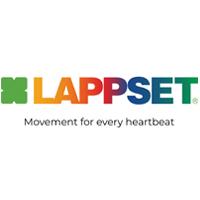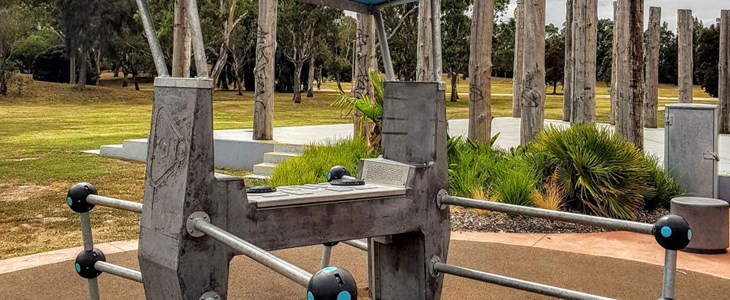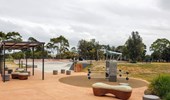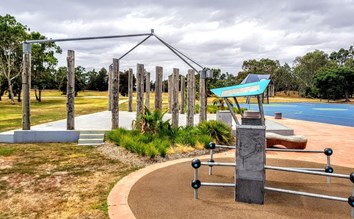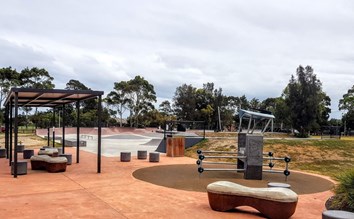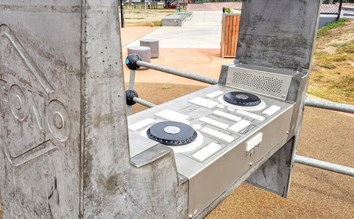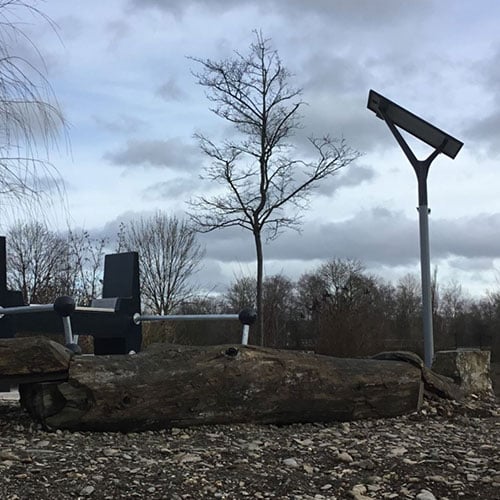Bicentennial Skatepark Chelsea
Chelsea, Australia
Project Details
- Location
- Chelsea, Australia
Our interactive playgrounds are great catalysts for inclusive play. Playground equipment should be as diverse as our communities and as our interactive play is truly inclusive and multigenerational that it easy to achieve. The great thing about our interactives is that we do not even intentionally plan for inclusion. With our innovative products, we unite everyone through the power of play because all people require the opportunity to test boundaries.
What if there was playground equipment that challenges all children, adults and seniors, regardless their ability?
The current play equipment for disabled are most often not challenging or fun because:
X Most playgrounds are often focused on just one disability
X Disabled children still face many barriers, both social and environmental
X Communication barriers prevent many disabled children to join in
X Most inclusive play areas are for children only so parents can’t play along
X There is a lack of play equipment that’s enhancing physical, emotional and social development
Inclusive play for older teens/young adults
Our interactive court Toro, interactive ball wall Sutu and DJ booth Fono also offer inclusive play opportunities for teens and young adults. Or even disabled parents and carers with different abilities. Our interactives are not only inclusive for children.
Settings to change the amount of introduced challenge
A public park that is frequented by many different people with varying impairments might prefer a very generic approach to the game settings. A special needs school with one-on-one supervision who knows their children extremely well might want to increase the challenge in the playground equipment in order to help them adapt to life outside. They might want to increase the variety of Sona audio samples and in doing so the opportunity to create uncertainty. The unpredictability as part of play might increase risk (esthetically the Sona is of course not risky).Together we can look at the different possibilities in settings.
We offer an inclusive play solution with interactive play equipment
In 2006 we started developing our first interactive play equipment, the Yalp Sona play arch. In over a decade we’ve realised more than 550 play areas worldwide. In various projects we discovered that our products suit the needs of children with disabilities astonishingly well.
Our vision is that everyone regardless of background, age, gender, and ability should have the same opportunities in life to explore and achieve. Though we still see that the group with special needs or disabilities is most neglected in playground design. Most inclusive play solutions that are being offered are often stigmatizing or not interesting enough.
We strive to create completely unique sports- and playgrounds that punctuate, not define a play space, embracing the true meaning of inclusion and adaptive play. The Yalp interactive products have no barriers, are not stigmatizing and are challenging and exciting for all ages and abilities.
Accessibility is our principal requirement
All of our interactives are ground level and therefore very easily accessible for people with physical impairments such as wheelchairs but also other mobility devices such as the increasingly larger powered mobility devices for more severe and complex special needs that might be too big for some of the traditional equipment. To us that’s just an obvious starting point. What is really important is what happens once an individual with special needs gets to the playground.
Inclusive play that focuses on multiple disabilities
There are many different impairments and even many ranges of abilities within those impairments. Different people with the same impairment are even impacted in different ways. We absolutely do not have a monopoly of wisdom. Most of our game development came through observations and conversations with special ed teachers, occupational therapist, medical practitioners and most importantly parents of special needs children. How do our interactives contribute to inclusive play?
Free versus structured play
Typically children with special needs are over-protected from opportunities. Interactives offer a fixed place on the playground where independence is encouraged. Because all of our interactives only have one button, almost all children are able to select their own games and make their own choices. This enhances intrinsic motivation. Children with special needs in the cognitive domain thrive with our interactives as they offer a variety of challenges. It is importance to offer situations in which they can take the lead, experience free play, are motivated to seek new challenges (the interactives also give audio feedback), develop competence and to simply let off steam. Too much free play however is not always beneficial for all.
What about for example children with an Autism Spectrum Disorder?
The level of disability of course vary greatly, but we at least want to give a few examples of how children with an Autism Spectrum Disorder play under for example our dance arch Sona.
Many children with ASD under- or overreact to sensory stimuli such as sound. Sudden noises might upset them. Usually there is also a resistance to change. The Sona settings can be programmed such that music and games are predictable. Certain games on the Sona provide structure and give precise and short instructions. The Sona will tells them what happens next, which is appreciated by people with fragmented perceptions. It gives clearness to prevent undesirable behavior.
Often children with ASD do not employ theory of mind and might not have the ability to understand one’s own mental state and those of other’s. The Sona gives positive encouragement and feedback after a certain task such as ‘you danced very well’. This way children experience pride and increase their self-confidence.
Some might have a resistance to being touched. Under the Sona caretakers can play beside them instead of having to stand in front of them as for some eye contact might be stressful or uncomfortable. Caretakers can assist verbally without having to touch them to facilitate play. This typically makes them feel safer.


